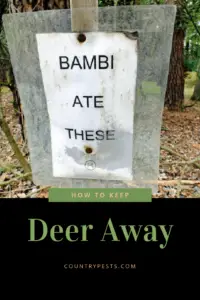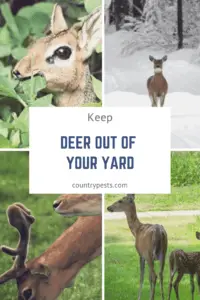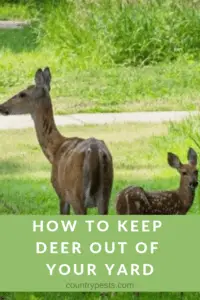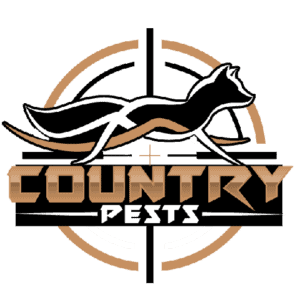
Cute, graceful and majestic. Deer are a wonder to watch until they ravage your garden or destroy your poppies. Even in the suburbs, deer are seldom shy about feasting on your favorite flowers, bushes, or garden. When they find plants they love, your yard becomes a 24-hour buffet.
Fortunately, there are many things that you can do to get rid of them. Some actions take purchasing commercial products, but many very successful steps cost almost nothing to implement.
Keep Deer Away From Your Yard, Garden, And Flower Beds
The following steps have been organized into steps of the easiest and most effective to the more costly, and often less-effective steps you can take. I address the success and the pros and cons of each step so you can find the best step for your property.
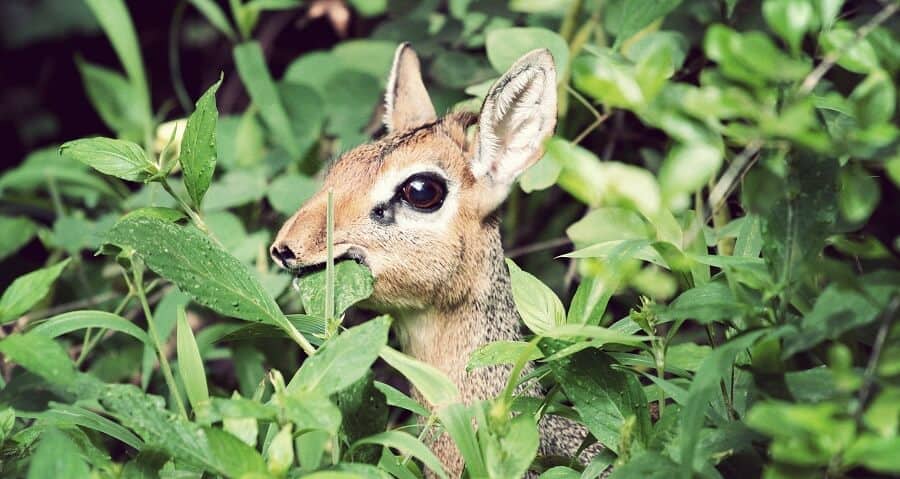
1. Use Fishing Line To Scare Deer Away
Deer have superb eyesight that is especially good at detecting movement across their entire vision. They don’t focus as well on individual details as the human eye but can notice much more peripherally. As a result, fishing line is an ideal tool to keep deer away.
When deer move into a crop to feed but feel fishing line brush their fur, it scares them. They aren’t sure what is touching them because they don’t focus on details as well and their “movement” eyesight didn’t warn them. That makes them bolt.
Plus, because of the uncertainty of the experience, they don’t come back many more times. Almost all animals will test an experience multiple times. That’s why some methods such as lights or plastic predators don’t work as well, because the animals get used to seeing them and nothing bad happening.
Fishing line is different though because deer can’t physically focus on the small fishing line. No matter how many times they go to a place and see it, they don’t see the fishing wire. At some point, while they get nearer to eat, their fur gets brushed and it startles them.
There are two methods involving fishing line you can use.
The Silent Method: To set up a fishing line, you will need some stakes and fishing line. Make sure the fishing line is at least 30 lb weight. You want it strong enough to sustain a good solid line and not to break at the smallest nudge.
Simply create a border about 1 foot high around the bushes, garden, or flower beds you want to protect. Wrap the fishing line around the same area at 1.5 feet, 2.0 feet, 3feet and again at 4 and 5 feet. (every 6 inches the bottom 2 feet and 1 foot apart up to 5 feet.) This will ensure that small and full-sized deer are touched by the fishing wire.
You can paint or mark part of the wire so that you can see it easily during the day and move around it to weed or access your garden.
Although the top line is not high, and deer could easily jump it, they don’t because they can’t actually tell how high it is and don’t know what is touching them.
Pros:
- Easy and low cost to implement.
- Effective
- The invisible border doesn’t mar the landscaping
- A fishing string is a great way to keep deer away from a garden without a fence
Cons:
- An invisible barrier can also catch people
2. Create Invisible Noise To Scare Deer
The next idea also involves fishing line and noisemakers. You will need a fishing line, raised platform and empty cans. The platform can be a 5-gallon bucket, lawn chairs, or even the edge of a raised flower bed.
This idea works well because the deer feel the fishing line and are startled, but as soon as they feel it, they also hear a crashing sound. It’s the difference between being startled by someone standing somewhere you didn’t expect and someone actually jumping out to scare you.
Use a fishing line that is between 10-15 lb weight.
You want a thinner fishing line in this method because it isn’t tied tightly to stakes and you don’t want the deer to become entangled. It needs to be light enough for them to break free of.
Simply take the fishing line and tie it to the empty cans. Tie the cans on both ends of the fishing line. The line should be as long as the border you are trying to protect. The cans can be paint cans, soda cans, or other type of can.
String the line up along the border you want to create and place the cans at both ends. You have an invisible border.
When the deer cross the border to nibble, they will pull on the string and simultaneously cause the cans to drop to the ground. This causes additional noise that scares them away.
They don’t feel the string as strongly because the cans move with the tug so this method uses more of a customized noise to scare them away. The noise occurs whenever they cross a boundary.
Pros:
- Low Cost
- Easy to set up
Cons:
- Noise at night count upset neighbors
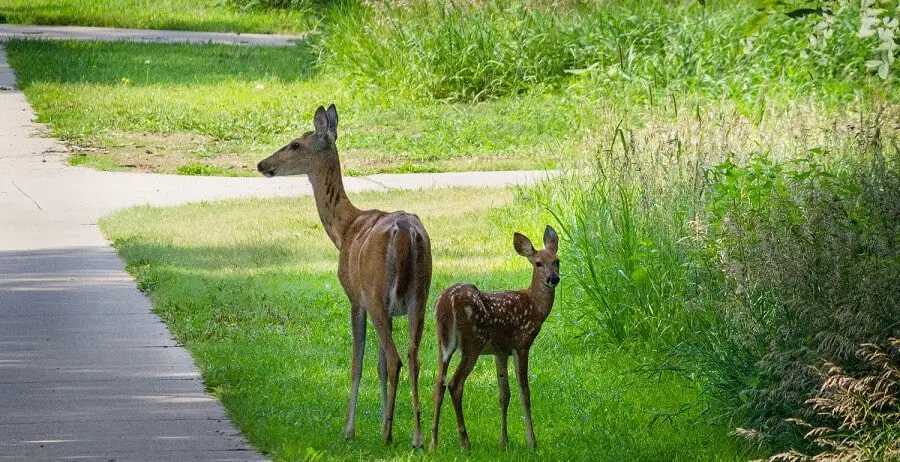
3. Use Irish Spring Soap To Mask Your Plants’ Smell
Irish soap has a unique recipe of ingredients that makes it particularly strong smelling to animals. Use the soap to repel deer through their sense of smell.
Cut the bar of soal into 2-3 pieces. Drill a hole through each piece and hang it in your trees and bushes. You can also hide and hang them in burlap bags.
If you are trying to protect fruit trees, then hang it 2-4 inches below the branch line. If you are trying to protect flowers, then hang it 2-3 inches above the flowers on a stake. Bushes can be protected by hanging it every 4-5 feet.
You may be able to get away with less soap if your deer problem isn’t as big. The University of Vermont Extension found that soap repels deer for about 3 feet out. That’s as much as 6 feet between bars of soap. They also found that tallow is soap is effective and you should not use soap with coconut oil in it or it will attract deer.
How small the pieces are will determine how effective they are. It may take a little experimenting. If deer are eating a tree that is farther from a bar of soap, then add another bar in the middle and check for further munching.
I haven’t used this method yet, but I have talked to a number of people who use it and love it. I am planning to use it as soon as I get my orchard planted this summer. I haven’t heard of a single unsuccessful attempt that used Irish soap. Plus, I’ve read several reviews regarding using Irish soap to rappel some other pest animals so it does seem suited to keep away herbivores.
Other soaps with tallow in them include Ivory, Dove, Neutrogena, Dial, Lever, Tone, Jergens, Zest, and Camay. They have various levels of tallow in them so their effectiveness will differ. Irish Spring’s first ingredient is tallow and that’s probably why it’s named more often than any other brand as being effective. (According to my unofficial survey of soaps.)
Pros:
- Very inexpensive
- Easy to implement
- Fast to implement
- Interspersed among the garden keeps deer away without the need for a fence
Cons:
- Some people may not like the smell of the soap either
- It may not be as aesthetically pleasing

4. Use Wind-Movement To Scare Deer
If you live in an area where the wind blows, take advantage of that to create visual movements. Because deer are so good at seeing movement peripherally, moving objects from the wind can startle them.
Try hanging up some CDs or tin pie pans in the trees to move with the wind. They will also reflect the sun and cause additional visual movement for deer.
Another idea is to put up white triangle flags. They flap and look like the white tails of deer, but the deer can’t see the rest of the deer. This is said to spook them because it doesn’t make sense to what they know. It’s sort of like using ghost deer to spook them.
You can set up other whirlygigs, pinwheels, and other moving things throughout your garden or flower beds.
Visual movement can be effective but should be moved around and used with some of the other methods mentioned. Overtime deer can overcome their startle reflex, especially if hunger drives them.
That’s most likely to happen in the winter and early spring.
Pros:
- Very inexpensive
- Simple to set up
Cons:
- If you only use this method, the deer will adjust to it with time.
- Its less effective in areas without wind
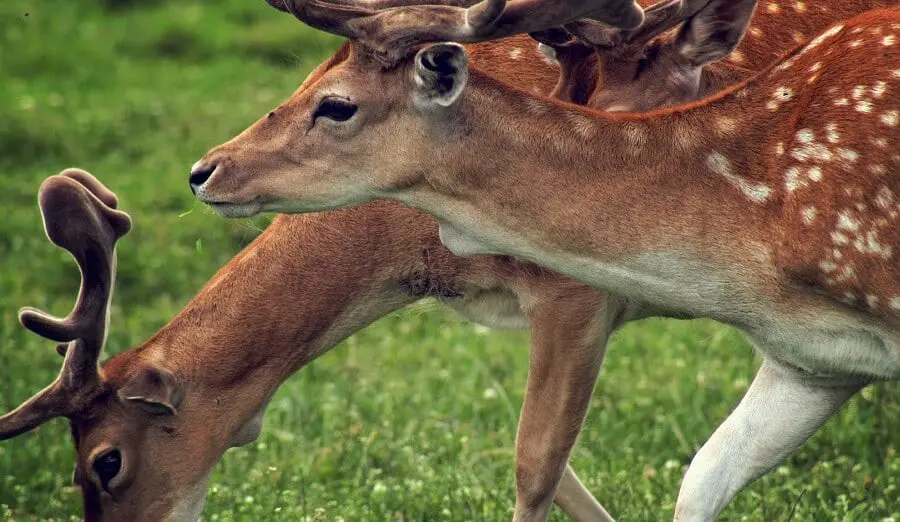
5. Use Wind-Propelled Noise
Set up windchimes, empty cans, and other noisemakers to startle deer. As the wind blows through the trees or bushes, it causes unexpected noise for the deer.
Try a variety of windchimes with different pitches, sounds, and heaviness. This will make the chimes sound at different frequencies, depending on the strength of the breeze. The various noises will help to keep the deer uncertain.
Deer can overcome scare tactics when they are hungry enough and they figure out that danger hasn’t arrived so it’s important to have a variety.
Pros:
- Windchimes make lovely music
- They add enchantment to an area
Cons:
- Deer can adjust to the noise or movement when they realize that there isn’t danger
6. Harvest Fruit, Veggies, and Nuts as Soon As Ripe
Keep from sending a personal invitation to deer by harvesting food as soon as it is ripe. Pick fruit trees before the fruit starts falling to the ground and rake up the fallen fruit.
Fallen nuts can be gathered and you can put the leftover nuts that you aren’t going to use on the edge of your property away from your other plants. This can help to feed the deer. They will stay away from other plants if they have enough nuts to eat. Deer prefer chestnuts over other woody plants and branches.
Keep your garden picked and clean of over-ripe vegetables. The more intense smell of ripened food attracts deer and other animals into your yard.
Pros:
- Keeps lawn and garden tidy
Cons:
- Takes more time
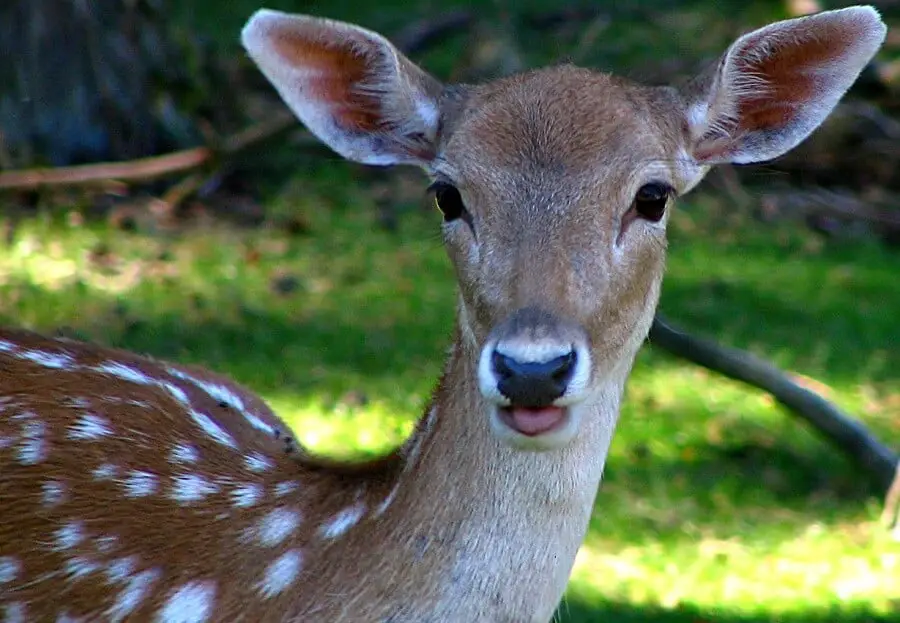
7. Plant Deer-Repellent Plants
Use fuzzy, hairy plants to discourage deer. They don’t like the feel of prickly leaves on their tongues. Plants with small hairs or that can prick you are good plants to keep deer away.
Below are a number of plants ideal for keeping deer away.
Some plants like lavender have a heavy scent and stick to their legs. This makes deer unable to smell predators nearby and puts them at dangerous risk. Smelly plants can also interfere with their ability to smell food.
| Fuzzy and Hairy Plants | Smelly Plants |
| Squash
Cucumbers Lambs Ear (Stachys) Lady’s Mantle (Alchemilla) Siberian bugloss (Brunnera) Flowering tobacco (Nicotiana) Tuberous begonias Heliotrope Yarrow (Achillea) Ageratum Poppies Purpletop vervain (Verbena fewer) Currents Barberries
|
Lavender
Oregano Catnip (Nepeta) Mint Marigold Sage Thyme Hyssop (Agastache) Artemisia Russian Sage (Perovskia) Boxwood (bruxus) Salvias Tansy (Tanacetum) Bee Balm (Monarda) Mountain Mint (Pycnanthemum) Dead nettle (Lamium) Blue mist shrub (Caryopteris) Dill Lantana Calamint (Calamintha) Cedar |
| Spiny Plants | Leather And Tough Plants & Trees |
| Bear’s Breeches (Acanthus)
Globe Thistle (Echinops) Cardoon Sea Hollies (Eryngium) Russian olive Grape Holly Rocky Mountain juniper Boxwood Chaste Tree Bluebeard Sweet Fox Japanese plum yew Japanese Maple Pine False cypress Tree Hackberry Tree Hawthorn Tree Palm Trees Spruce Magnolia |
Irises
Wax Begonias Dragon Wing Begonias Elephant Ears (Colocasia and Alocasia) Peonies Viburnums Leatherleaf Arrowhead Figs Climbing Bamboo Drooping Leucothoe Bayberry Mahonia Ginkgo Black Locust |

Deer love the new shoots of trees, bushes and plants. The tender shoots of flowers just emerging during spring.
Deer are the very hungriest during the cold winter months and the early spring when the does are in gestation. Mating season is January and February so until the fawns are born, the does are eating for two.
This means that many deer will venture and eat plants they usually wouldn’t eat other times of the year. That’s why many of these plants aren’t deer-proof, they are only deer-resistant.
White tailed deer, the most common deer in North America, can’t survive on grass alone. Therefore, they tend to avoid it unless they are very hungry.
Pros:
- Many of these plants are beautiful and useful to people
Cons:
- More costly to purchase plants
- Takes more time to get plants established

8. Plant Deer Poisonous Plants
Plants that are toxic to deer are more readily avoided. When these plants are interspersed with plants deer like it makes the deer less likely to eat other plants because of the scent of the poisonous plants.
Fawns learn from their mothers which plants to eat and which ones to avoid. Therefore seeing leaves interspersed among other plants makes them more hesitant.
Poisonous Plants To Deer:
- FernsFalse Indigo (Baptisia)
- Bleeding Hearts (Lamprocapnos / Dicentra)
- Daffodils
- Helleborus
- Monkshood (Aconitum)
- Spurges (Euphorbia)
- Poppies (Papaver)
Be cautious about planting some of the plants because they can also be toxic to humans and animals. If you have small children, be strategic about where they are planted. Make sure your dog doesn’t chew on plants before using poisonous plants to ward off deer.
Pros:
- More effective plants
Cons:
- Can be poisonous to humans also
9. Plant Deer-Favorite Plants Closer To Your House
Deer that are used to going into suburbs, neighborhoods, and searching in yards for food tend to be pretty people friendly. They lose their fear of people. But, even more, socialized deer still tend to be jumpy when very close to people.
You can help to protect your favorite fruits and flowers by planting the deer-friendly plants close to your house. Bring your strawberries and raspberry beds closer. Bring in those tulips, hostas, sunflowers, and petunias close to your deck and windows.
Pros:
- Helps to protect the plants that are loved by people and deer
Cons:
- Some people don’t want to rearrange their existing landscaping

10. Let The Dogs Out
If you a have a dog, letting it out will scare the deer away. Wolves are natural predators of deer and deer are naturally afraid of a dog’s bark. Plus dogs usually love to chase and harass deer.
This method is one that usually works without other methods, but Lassie has to be outside all the time
Pros:
- Very effective
Cons:
- Neighbors might not appreciate barking at night
- Not all dogs are outside dogs all the time
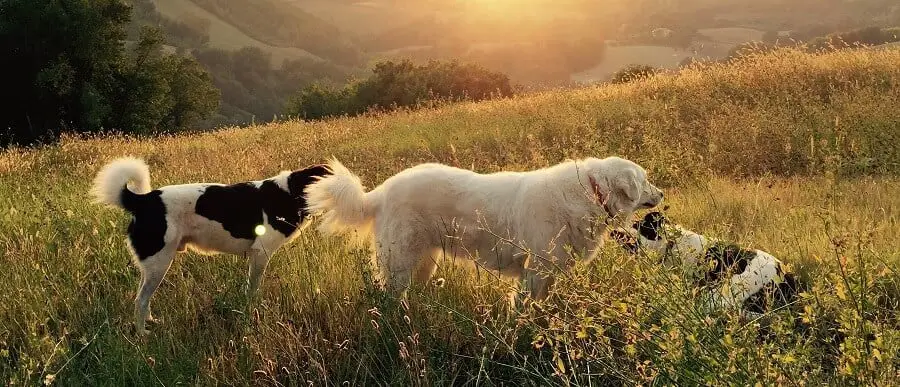
11. Keep Deer Away From The Birdseed
Leftover bird seed is a great feast for a hungry deer. Put away the birdfeeders, especially in the winter when deer are more hungry.
If you love birds and you want to keep feeding them, there are a few steps you can take to reduce your deer population without leaving the birds in a lurch.
What can I do to keep deer away from bird feeders?
First, use no waste bird seed. Many types of bird seeds have a lot of filler seeds that the birds don’t really like. This causes them to sift through the birdseed for the seeds they like best. Purchasing a no-waste bird seed cost more than the filler seed packages, but it will get eaten and not sifted through.
That means little to no birdseed on the ground. It also means less rodents and less food for deer.
You can purchase a catcher to gather the spilled birdseed. It keeps the husks and extra seed from falling as well.
Lastly, you can move the bird feeders to the edge of your property away from the plants that the deer ravage. This brings the deer away from more tender plants and keeps the birds from going hungry.
Pros:
- Managing your bird seed waste helps to cut down on the rodent population as well
- Keeps deer away from tender plants
Cons:
- This is more of a preventative measure, rather than something that keeps deer away
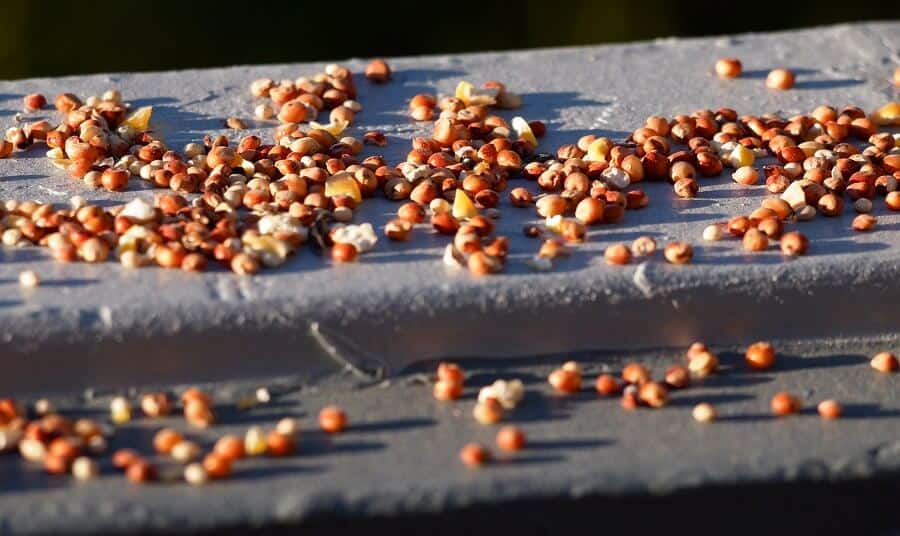
12. Trim Bushes and Eliminate Predator “Cover” For Deer
Deer like to have a place to hide in case a predator shows up. Make your home less inviting by trimming bushes. This eliminates areas that deer can hide in. It makes the deer more vulnerable.
Deer are edge animals. They love to live in the woods and come into the edges of the meadows to eat. But they usually don’t venture far into meadows because there aren’t any good places to take cover. That makes them more vulnerable.
The same is true in a yard.
Pros:
- Helps to keep deer skittish
- No cost
Cons:
- It may affect the desired visual appearance of the property
- Most yards still provide some “cover” in the form of bushes, buildings or other plants
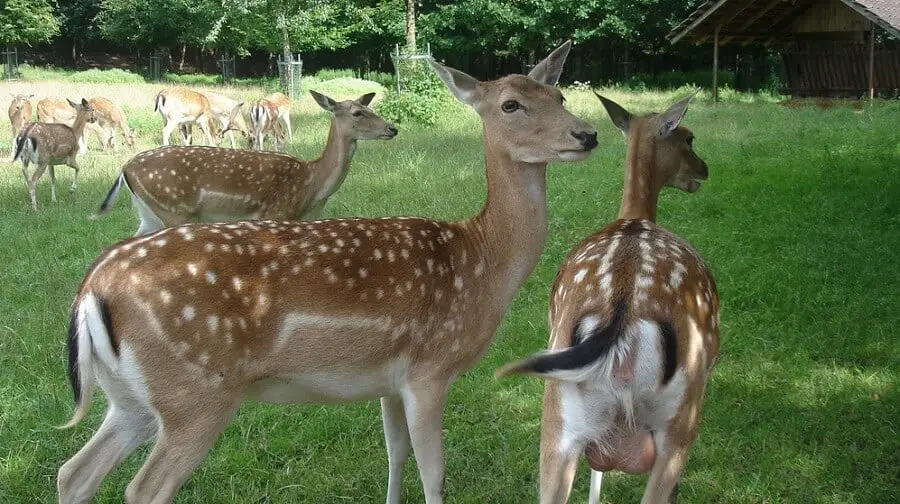
13. Use Deer Netting To Protect Valuable Plants Or Crops
Use deer netting to keep the deer from munching on your fruit trees. Cover garden plants with netting and keep your tomatoes protected. You have to secure the netting well or it can come off of plants and leave them vulnerable.
Deer netting can also be used as a visual barrier to food sources. The netting creates an opaque fence that makes deer hesitant to jump over. However, in the dark, it can be harder to see so attach some colored flags to the top so it’s easier for the deer to see.
Tree wraps can be secured to keep the bark and new sprouts of trees safe from deer.
Pros;
- Relatively inexpensive compared to other commercial solutions
Cons:
- It’s not attractive
- Animals can sometimes knock them off
14. Plant An Oak Tree
Acorns are a powerful source of calories and nutrients to deer. They usually prefer acorns over other types of green plants. If deer have access to acorns or chestnuts, they will eat them over green vegetation. That’s because acorns and chestnuts will give deer the powerful calorie burst to get them through a colder and scarcer winter.
Planting an oak tree can provide the deer in your area with an abundance of food that keeps them away from other plants.
But, oak trees often kill the plants living underneath the tree. Only certain plants can cohabitate with an oak. That means that you won’t have flowers lining your tree trunk. That because they give off a hormone that kills the plants that compete with it for nutrients.
Plus, oaks don’t always produce acorns every year. Some years they will produce abundantly and then the next, they will produce very few acorns. Oaks go through reproductive cycles. This method may be more effective in some years than in other years.
Pros:
- Oak trees are great for air quality and add beauty to a yard
- Help to feed the deer and keep them away from delicate plants
Cons:
- Not consistent acorn production
- Not all plants can co-exist with oak trees

15. Use Predator Urine
Cougars, wolves, or fox urine can all be effective against deer. (Check out my resource page on Best Animal Repellents for suggestions) Dog urine can also be effective. Deer can smell the scent of predators and it spooks them. Even predators that aren’t native to deer is supposed to work such as lion urine.
But, predator urine can be applied too scarcely. It can wash away, or it can take a lot to cover all of the area needed.
Pros:
- Easy to use and apply
Cons:
- Not everyone has access to predator urine
- Not all predators work as well as another
- Ongoing cost to reapply
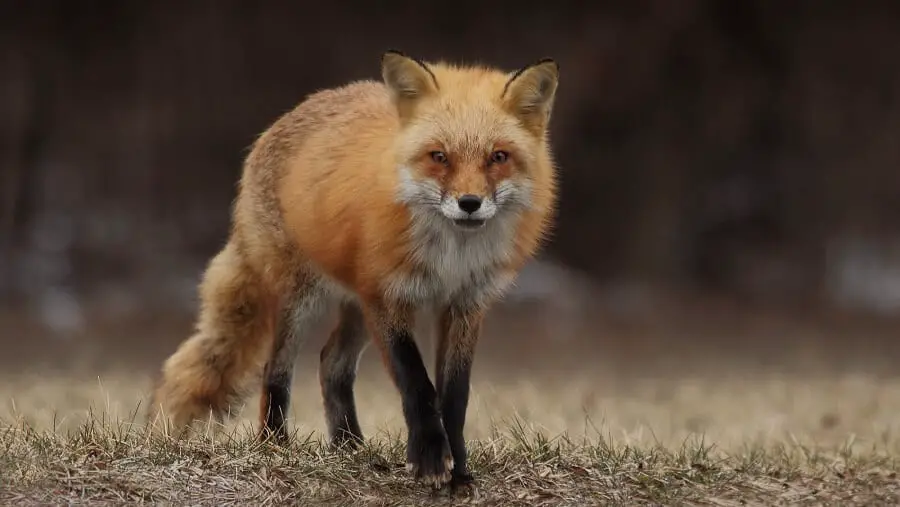
16. Motion Activated Sprinklers
Motion activated sprinklers use an infrared motion detector so that they work at night. They can be set along the perimeter of where deer are restricted. As soon as deed cross that border, the sprinkler turns on and hits the deer.
They usually hook up to a hose and many are solar or battery powered. Taller sprinklers work best for deer so that they don’t go off for ground squirrels and other small animals.
Pros:
- Effective and water the area also
Cons:
- Multiple ones are often needed to protect an area.
- Don’t work when during cold seasons due to freezing hoses.
17. Commercial Repellents
There are several commercial repellents that can be effective against deer. However, they should be rotated every 2-3 months to be effective because deer can get used to the taste and the smell.
Plus, some repellents work during specific seasons better than others. Apply the repellent as strong or stronger than the directions. Reapply after rain or at least weekly to be effective. They almost always require reapplication more frequently than the directions state.
Egg-based repellents are usually more effective than other repellents.
Pros:
- A simple fix
Cons:
- Costly. Requires ongoing maintenance.
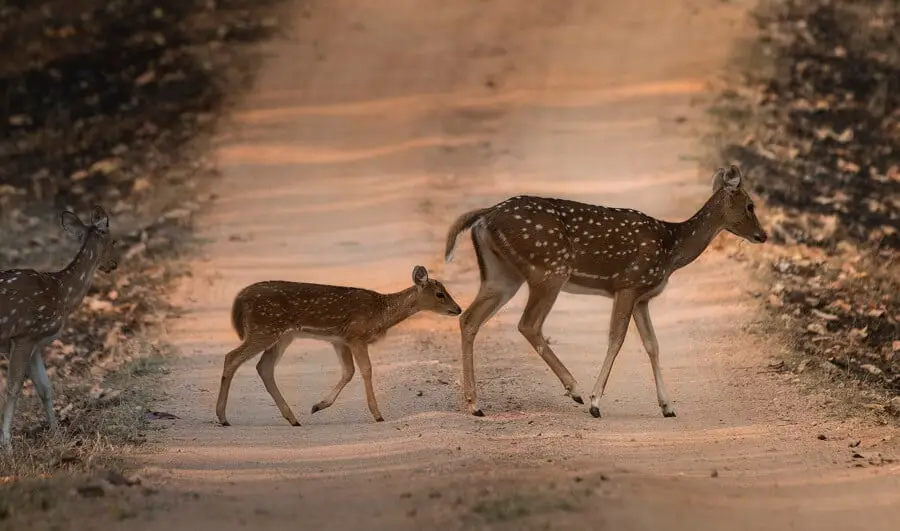
18. Add Terraces To Your Yard
Deer don’t like to go over uneven ground. It makes them uneasy and they aren’t able to feel through their hooves. Rocks are more slippery and dangerous.
As a result, deer like to stay in areas with a gentle slope.
Discourage deer from your property by creating a grade in your lawn. Add terraces, various levels, and inclines. Place large rocks as part o the landscaping. Add your garden into raised beds.
This makes deer more nervous and adds danger for them.
Pros:
- Terraced landscaping is loved by many people
Cons:
- A lot of work and expense to create an even yard into a terraced one.

19. Deer Fence As A Barrier
Deer are able to jump as high as 10 feet high. Therefore any fence designed to keep deer out must be high and it must be opaque.
An 8 ft fence that is solid will discourage deer from jumping over it because deer don’t like to jump over things they can’t see through. They don’t know where they are jumping or what’s on the other side.
A 10 ft fence that is see-through is usually high enough to keep deer from jumping it.
Another option is to put a dual fence up. Two fences 5-6 feet apart create a narrow place for deer. They don’t like to be boxed in and like to have space. As a result, deer won’t jump into a confined place.
Electrical fences and bush fences are other options that tend to be effective. Electric fences can be thought to be dangerous to people. But if handled right, they don’t do any harm. They should be set at the right volts to not kill a deer. Check out this guide on electric fences for all the info you need on voltage and setup. Bush hedges make it hard for deer to see through, but should be a taller hedge, at least 8 feet.
Pros:
- A fence will keep out other animals as well and further protect your garden
- Very effective
Cons:
- Expensive
- Labor intensive. lots of time to set up
- Drastically changes the look of the landscaping.
- Electric fences can harm children and may not be legal in many cities
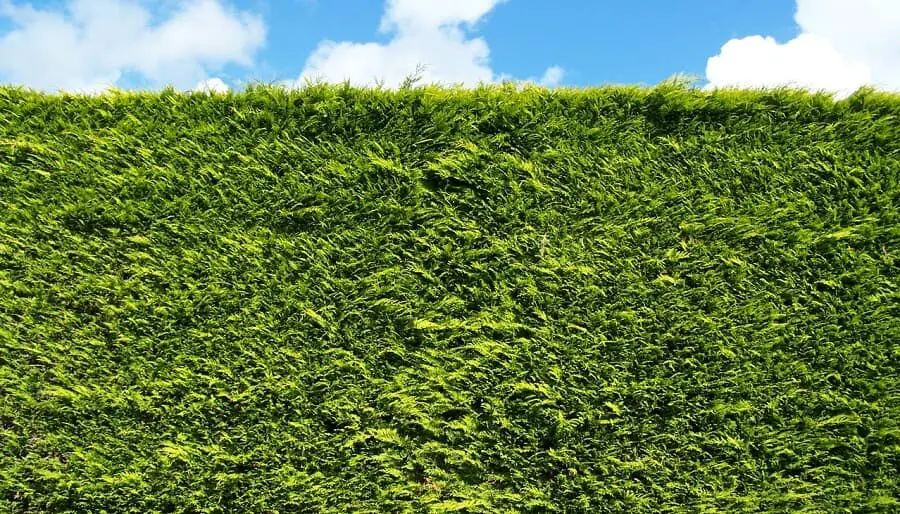
20. Human Hair To Smell Like People Close By
It’s something that is rumored to be effective for a great many wild animals, deer included. The scent of human hair should spook deer into running away.
However, many deer have grown used to the human scent as they come down into our neighborhoods and lawns. Human hair also doesn’t have a super strong scent. It may not smell at all in the outdoors compared to ripe fruit or other leaves or flowers.
]So, it takes a lot o human hair to be effective, if its effective at all.
This is probably one of the last resorts I would attempt.
Pros:
- Cheap, most people have hair
Cons:
- Difficult to get enough to be effective unless you are a beautician or barber
- Can be embarrassing to ask people for their hair
- Not as effective in areas of higher populations where deer are already used to people smell

21. Rotate Repellants to Various Areas
Keep the deer guessing if your yard is safe or worth the effort. Use a combination of various methods to be more effective. Some methods will work better in certain climates or among specific populations of deer than others.
Not all methods will work equally effectively on all deer.
Keep Deer Away From The Garden Without A Fence
There are several steps you can take to keep deer away from a garden without a fence. Many of the methods above work wonderfully, but the very best ones are listed in this section.
- Use Irish Soap interspersed among your tomatoes, peas, strawberries, and melons. Instead of hanging from the trees, hang it from tomato cages, or put it on a stake above the strawberries.
- Plant cucumber, squash plants, and marigolds interspersed with vegetables. The prickly sensation doesn’t feel good on deer tongues. The Native Americans used to grow corn and squash together and that may have been partially caused from deer eating the corn.
- Use motion activated sprinklers to startle deer away. Place sprinklers around the perimeter of the garden.
- Use fishing line to create an invisible fence around the garden. It’s not visible to people, but keeps deer out.
- Avoid using commercial products unless you are aware of their contents because they will dissolve and go into the soil.
Related Articles:
You might find these related articles helpful.
How To Keep Pests Out With Electric Fence
Differences Between Deer Ticks and Regular (Wood) Ticks & Protection Against Them
Cover picture Credit: Hans Splinter on Flickr
